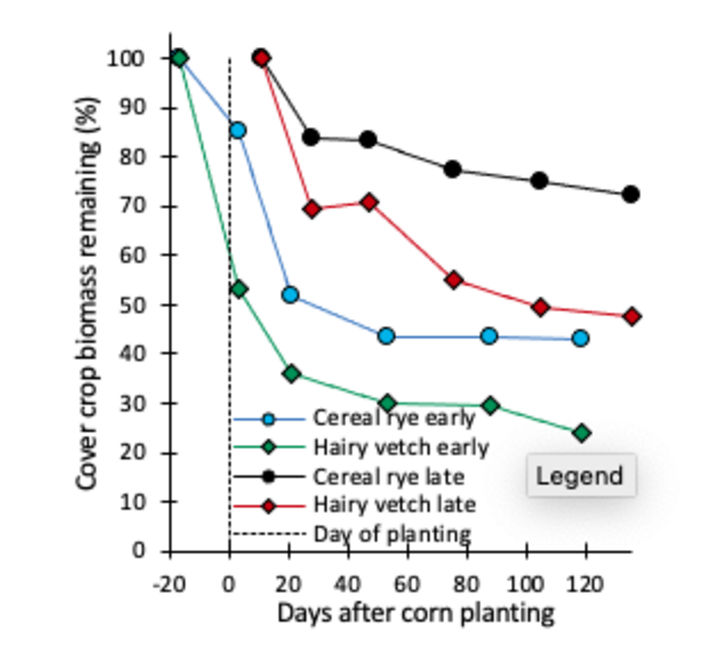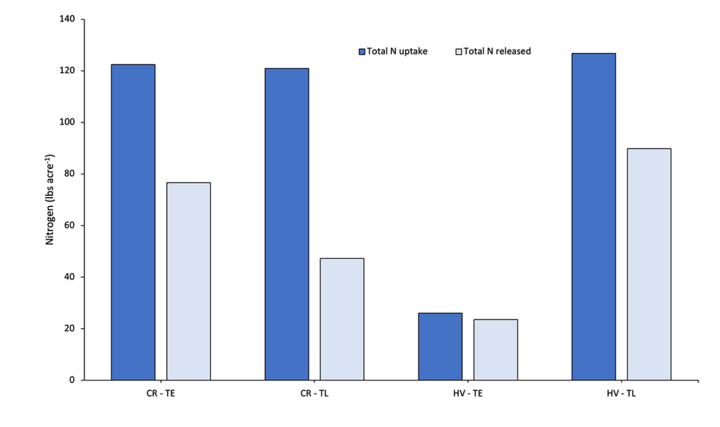Well-managed grass and legume cover crops offer nitrogen cycling benefits. Grass-cover crop species, such as cereal rye (Secale cereale L.), can scavenge residual nitrogen (N) from deep soil layers, avoiding losses by leaching and releasing them as residues decompose (Blanco-Canqui et al. 2011). Legume cover crops, such as hairy vetch (Vicia villosa), biologically fix atmospheric N and release it during decomposition, helping supply the N for the subsequent cash crop (Enrico et al. 2020). The speed of this nutrient release depends on the carbon-to-nitrogen (C-to-N) ratio of the residue and weather conditions such as temperature and rainfall amount.
While later cover crop termination in the spring can allow for more biomass accumulation, such later termination can change the C-to-N composition of the plants impacting residue decomposition. Therefore, identifying the best time for cover crop termination to provide optimal nitrogen cycling benefits can help farmers make decisions about cover crop management. This study aimed to evaluate the impact of the termination time of cover crops on their decomposition and N release.
Field Management and Analysis
The decomposition of cover crops and N released was evaluated throughout the corn growing season using "litterbags," a common method used in crop decomposition research. Litterbags consist of mesh material where plant residue is placed to monitor its decomposition. This experiment was conducted in 2022 at the Eastern Nebraska Research and Extension Center (ENREC) near Mead, Nebraska.
The experimental design is a randomized complete block design (RCBD) with four treatments and two replications. The treatments consisted of (1) cereal rye terminated early (CR-TE), (2) cereal rye terminated late (CR-TL), (3) hairy vetch terminated early (HV-TE), and (4) hairy vetch terminated late (HV-TL). The cover crops were planted on Sept. 30, 2021, following soybeans.
We collected 1 m2 of aboveground cover crop biomass from each cover crop treatment on May 10 (early termination), and May 31 (late termination), which were before and after corn was planted on May 20, 2022. Cover crop biomass samples were weighed and separated into six equal parts, and each one of these parts was used to fill one litterbag. One of the litterbags was collected on the same day as the sampling (considered as "Week 0") (May 10 for early termination, and May 31 for late termination). The others were placed in the field and collected on two, four, seven, 11, and 16 weeks after the cover crop was terminated. All statistical analyses were performed on R software (R Core Team, 2022), using lme4 (Bates et al., 2015) and emmeans (Lenth, 2020) packages. The samples were dried, weighed, ground and analyzed for total nitrogen content.
Biomass Production and Decomposition During the Corn Growing Season
The total biomass production ranged from 8,180 lbs per acre for cereal rye terminated late to 3,310 lbs per acre for hairy vetch terminated early (Figure 1). Cereal rye produced more biomass when terminated later (Figure 1), while the biomass production of hairy vetch was not different between termination times (Figure 1). Both treatments of hairy vetch and cereal rye terminated early decomposed faster than cereal rye terminated late (p

CR-TL: cereal rye terminated late
CR-TE: cereal rye terminated early
HV-TL: hairy vetch terminated late
HV-TE: hairy vetch terminated early

It is well known that the C-to-N ratio is one of the drivers of plant decomposition. As we can see in Table 1, the C-to-N ratio of the cereal rye terminated late is higher than all the other treatments (p
Despite the higher biomass production of cereal rye terminated late, the total N uptake by the biomass was similar in both termination times of cereal rye, averaging 120 lbs acre-1 (Figure 4). Regarding the nitrogen released throughout the cover crop decomposition, there was no difference in the release rate of nitrogen among the cover crop treatments (p>0.05) (Figure 3). However, the proportion of nitrogen remaining in cereal rye terminated late, at the end of the season, was higher than in all the other treatments (p-1 more N than cereal rye terminated late (Figure 4). The higher C-to-N ratio of the cereal rye terminated late likely reduced the amount of nitrogen released (Table 1).


CR-TL: cereal rye terminated late
CR-TE: cereal rye terminated early
HV-TL: hairy vetch terminated late
HV-TE: hairy vetch terminated early
Hairy vetch terminated early released only 21 lbs acre-1 of N, but this was 91% of the total N accumulated by this cover crop species terminated early (Figure 4). In contrast, hairy vetch terminated late had 4.9 times more nitrogen in its biomass than when it was early terminated, and over the season, it released 71% of its total nitrogen (Figure 4).
On the day of corn planting, the remaining N in cereal rye terminated early and hairy vetch terminated early was about 80% and 55%, respectively (Figure 3). The late termination treatments continued to take up N until the termination period, 11 days after corn planting or another approximately three weeks after the earlier termination treatments. However, only hairy vetch increased the total nitrogen uptake from early to late termination (Figure 4). Also, even with a higher amount of biomass production, cereal rye terminated late released less nitrogen than cereal rye terminated early. Consequently, the low decomposition of cover crops and low N release is associated with the C-to-N ratio (Table 1).
It is well established that cover crop species with lower C-to-N ratio residues, such as legumes, decompose more quickly than those with higher C-to-N ratio residues, such as grasses. Thus, selecting cover crop species and the termination time are important management considerations that can help minimize N immobilization, negative impacts on cash crop yield, and possibly reduce the N fertilization requirements for cash crops.
| Termination Time | Cover Crop Species | |
|---|---|---|
| Hairy vetch C-to-N ratio |
Cereal rye C-to-N ratio |
|
| Early | 11.6 bA | 18.1 aB |
| Late | 10.1 bA | 23.6 aA |
Means followed by the same lowercase letter in the row and upper-case letter in the column are not significantly different according to Tukey's test at p
It is commonly assumed that terminating cover crops two to three weeks before planting reduces risks associated with allelopathy and soil moisture. Additionally, early termination of cover crops creates a window of time in which N immobilization in the soil can occur before the cash crop's high nitrogen demand stage, preventing the reduction in yields. In addition, adopting the "planting green" practice (late termination of cover crops) should be analyzed with caution, as N immobilization may occur, reducing the yield of cash crops — especially in seasons with low precipitation, such as 2022.
This experiment started in 2021 and will end in 2023; however, the cover crop decomposition and N release were only assessed in 2022. We have also reported the influence of cover crops and their termination timing on corn grain yield in 2021 and found that corn yield was reduced when following cereal rye terminated late, while there was no reduction in corn yield when following cereal rye terminated early, and hairy vetch terminated early or late, compared to no cover crop treatment.
Summary
We evaluated cover crop decomposition in cereal rye and hairy vetch at two termination times, 10 days before corn planting and 11 days after planting.
Cereal rye terminated late had a higher C:N ratio, decomposed more slowly and released less N over the course of the corn growing season, compared to other cover crop treatments. This treatment also reduced corn yields compared to a control and other cover crop treatments.
Hairy vetch terminated late did not produce more biomass than hairy vetch terminated early, but did greatly increase N uptake in this period, and also released significantly more N over the growing season. Planting corn “green” into hairy vetch, allowing hairy vetch to grow and uptake more N was successful in our experiments.
Acknowledgments
The authors would like to thank Precision Sustainable Agriculture (PSA) Project (award number 2019-68012-29818) and Daugherty Water for Food Institute for funding and support, as well as Tom Galusha and Roy Cumming for their support with field management.
References
Blanco-Canqui, H., Mikha, M. M., Presley, D. R., and Claasen, M. M. 2011. Addition of cover crops enhances no-till potential for improving soil physical properties. Soil Science Society of America Journal. 75, 1471-1482.
Enrico, J. M., Piccinetti, C. F., Barraco, M. R., Agosti, M. B., Eclesia, R. P., and Salvagiotti, F. 2020. Biological nitrogen fixation in field pea and vetch: response to inoculation and residual effect on maize in the Pampean region. European Journal of Agronomy. 115, 126016.
